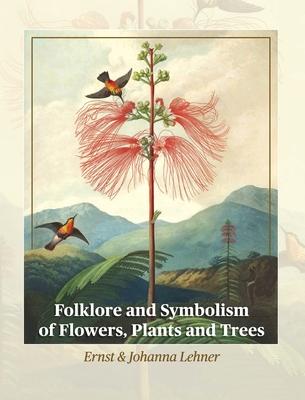Folklore and Symbolism of Flowers, Plants & Trees by Ernst & Johanna Lehner explores the cultural significance and legends surrounding much of the natural world. Ernst Lehner (b. 1896, d. 1971) and wife Johanna were Austrian natives who emigrated to the United States in 1940, likely fleeing the Nazis. After settling in New York City, the couple embarked on a literary and illustrative pursuit, writing numerous books together that examined the world of symbolism and legend.
These works include Astrology and Astronomy (1964), A Fantastic Bestiary: Beasts and Monsters in Myth and Folklore (1969), Devils, Demons and Witchcraft: 244 Illustrations for Artists and Craftspeople (1971), and Folklore and Odysseys of Food and Medicinal Plants (1973).
Folklore and Symbolism of Flowers, Plants & Trees (1960) turns this interest in iconography and mythology to the mysteries of growing things. "Throughout human history," they write in the introduction, "flowers, plants and trees became so interwoven with man's daily life that they developed into symbols for his expressions and sentiments, his passions and affectations, his beliefs and religions, his fears and superstitions."
Broken into five sections, this fully-illustrated work explains the meaning behind real plants and flowers, as well as those that are now considered legend.
Beginning with Sacred Plants, the Lehners describe the legends surrounding real plants, such as the acacia used to build the Arc of the Covenant, and the bo tree, under which the Buddha sat until reaching Nirvana. Other trees are strictly representative, such as the Tree of Life which is seen in nearly all cultures and religions.
In Flower Lore and Legend, stories from Greek and Roman mythology and European cultures attempt to make sense of the seasonality of flowers, their healing properties, where certain species grow, and how they inspired the greater world-all in an attempt to "explain the unexplainable."
The acanthus, for example, is said to be the inspiration for the famous Corinthian column. The Greek legend says that a young girl of Corinth fell ill and died. Her nurse collected her ornaments and trinkets in a basket and placed the basket on the tomb above the roots of an acanthus plant. She placed a flat tile on top to prevent rain from getting in. When the acanthus sent forth its stalks and leaves in spring, they spread over the basket and bent back down beneath the tile. A sculptor and architect passed by and was so pleased with its appearance that he recreated it in a column capital, which became the ornate Corinthian column.
In Strange and Wondrous Plants, we learn the stories of many fantastic plants and the sometimes miraculous wonders they're capable of. In reality, many of these stories were total fabrications or vast exaggerations of the truth. The roots of the carlina thistle, for example, were said to give a man "the strength and sexual potency of a stallion," which has no basis in fact.
The annual plant cycle is the subject of The Flower Calendar, which reveals which flowers and plants symbolized the months of the year in the European Middle Ages, the 17th century, and the 18th century, as well as in China and Japan.
Finally, The Language of Flowers lists the sentiments behind different flower types. In order to bring the right flowers to the right occasion-celebration, courtship, sympathy, gratitude, friendship-one must know what each bloom or plant represents. The white lily, for example, symbolizes both virginity and motherhood, while the snowdrop represents hope and consolation.
